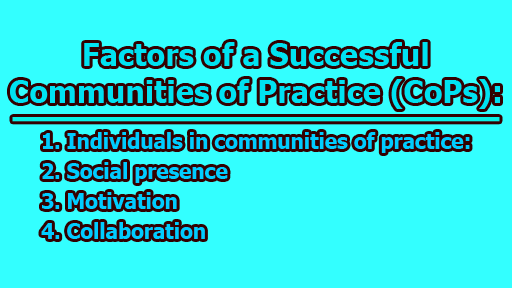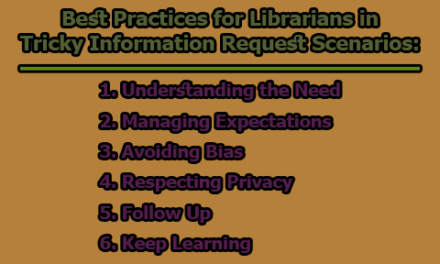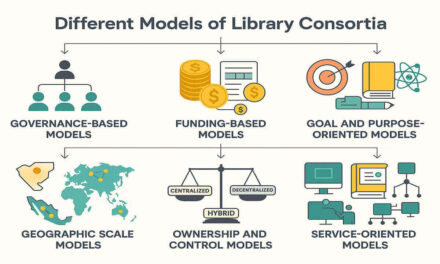Communities of Practice (CoPs):
Communities of Practice (CoPs) have emerged as dynamic and influential entities within modern organizations, fostering collaborative learning, knowledge sharing, and professional growth. Coined by Jean Lave and Etienne Wenger in 1991, the concept of CoPs encompasses groups of individuals who come together driven by a shared concern, passion, or set of problems. These communities transcend geographical boundaries, connecting members through collective social practices. In the following article, we will exploring definitions, functions, benefits, characteristics, roles, and the factors of a successful Communities of Practice (CoPs).
Definitions of CoPs:
Communities of Practice (CoPs) is a term originally coined by Jean Lave and Etienne Wenger in 1991. The communities of practice (sometimes incorrectly referred to as “communities of practices“) consists of members who interact with each other for their pursuit of a common practice. Therefore, it is collective social practice that links individuals together across all physical boundaries.
Wenger defines CoPs as “groups of people who share a concern, a set of problems, or a passion about a topic, and who deepen their knowledge and expertise by interacting (communicating) on an ongoing basis.”
A CoP is, in fact, a group of people who learn together and create common practices (habit/routine) (McDermott, 1999).
According to American Heritage Dictionary (1996), A communities of practice can be referred to as “a group of people having common identity, professional interests and that undertake to share, participate and establish a fellowship (association/partnership)“.
Brown and Duguid (1991) mention that members of a CoP should work together on a regular basis to find solutions to common problems, and then evaluate the achieved results together.
Thus, CoPs are formed by people who engage in a process of collective learning in a shared domain of human endeavor.
The purpose of CoPs is to share knowledge and experience, so that each individual can operate more effectively. By exchanging stories, problems and solutions, the CoP can bring their collective knowledge to bear on individuals’ problems.
Functions of CoPs:
- Communities of Practice facilitate the exchange and dissemination of knowledge among their members, fostering a culture of shared expertise.
- Serving as informal learning platforms, CoPs encourage ongoing learning and growth through collaborative discussions and interactions.
- These communities provide a space for collaborative problem-solving, allowing members to collectively address challenges and devise effective solutions.
- CoPs serve as networking hubs, connecting individuals with similar interests and enabling the building of professional relationships.
- Within CoPs, experienced members take on mentoring and coaching roles, guiding newcomers and facilitating skill development.
- Members of CoPs actively cultivate their expertise by engaging in focused discussions and collaborative activities centered around their shared domain.
- Knowledge capture and dissemination are essential functions of CoPs, as they help transform tacit knowledge into accessible resources for the entire community.
- By encouraging the exchange of diverse perspectives and ideas, CoPs promote a culture of innovation, driving creative problem-solving.
- CoPs enable swift adaptation to changing needs and technologies by leveraging collective insights to inform and enhance practices.
- Collaborative projects within CoPs lead to the creation of valuable resources and tools that benefit the entire community, fostering a spirit of mutual support and growth.
Benefits of CoPs:
Communities of practice are important in modern organization, especially knowledge-based organization:
a. Connect people who might not otherwise have the opportunity to interact, either as frequently or at all.
b. Provide a shared context for people to communicate and share information, stories and personal experiences in a way that builds understanding and insight.
c. Enable dialogue between people who come together to explore new possibilities, solve challenging problems, and create new, mutually beneficial opportunities.
d. Stimulate learning by serving as a vehicle for authentic communication, mentoring, coaching, and self-reflection.
e. Capture and share existing knowledge to help people improve their practice by providing a forum to identify solutions to common problems and a process to collect and evaluate best practices.
f. Introduce collaborative processes to groups and organizations to encourage the free flow of ideas and exchange of information.
g. Help people organize around purposeful actions that develop tangible results.
h. Generate new knowledge to help people transform their practice to accommodate changes in needs and technologies.
Characteristics of CoPs:
Communities vary greatly from each other by membership composition (e.g. very homogeneous or very diverse), dispersion (small and community-focused or international virtual networks), and purpose (very closely-defined or broad and far-reaching).
The key characteristics of CoPs are a community (a set of people) with a defined domain (what they care about or do) who work on the body of knowledge about their practice (their work).
Three basic characteristics are identified by Wenger (2006).
- The domain: A CoP is not merely a club of friends or a network of connections between people. A domain of knowledge creates common ground, inspires members to participate, guides their learning and gives meaning to their actions. It has an identity defined by a shared domain of interest.
- The community: The notion of a community creates the social fabric for that learning. A strong community fosters interactions and encourages a willingness to share ideas. In following their interest in their domain, members engage in joint activities and discussions, help each other, and share information. They build relationships that enable them to learn from each other.
- The practice: A CoPs is not merely a community of interest-people who like certain things. Members of a CoPs are practitioners. They develop a shared collection of resources: experiences, ideas, stories, tools, and ways of solving problems— in short a shared practice.
Roles and Responsibilities in CoPs:
The success of communities of practice depends on the individuals’ role. Community members may take an active role by contributing to discussions or providing assistance to other members. In almost every case, the more participation that occurs in the community, the greater the value created for both community members and community creators.
In a CoPs, different individuals plays different roles. A. Kim (2000) lists the key roles as (1) visitors, (2) novices, (3) regulars, (4) leaders, and (5) elders.
- Visitors may visit once or twice and may or may not join in communities. At this point, they are merely curious and are seeking to find out what the community is all about.
- Novices are new members, who typically keep distance at first until they have learned enough about the community and the other members.
- Regular members who become regular after the period of novice. They provide regular contributions and interact with other members on a sustained (continuous) basis.
- Leaders are members who have the time and energy to take on more official roles such as helping with the operation of the community.
- Elders are similar to subject matter experts. They are familiar with the professional theme and the community, and they have become respected sources of both subject matter knowledge and cultural knowledge.
Nickols (2000) defines more officially community roles. The major CoP roles include a champion, a sponsor, a facilitator, a practice leader, and information/knowledge integrators.
- The champion ensures support at the highest possible level, explains the purpose, promotes the community, and ensures impact.
- The sponsor serves as the bridge between the CoP and the rest of the formal organization, communicates the company’s support for a CoP.
- Community members are recruited for their expertise. By participating actively in communities work, they share knowledge, know-how, and best practice to other members. Besides, they participate in discussions, raising issues and concerns regarding common needs, alert other members, and contribute to enhance effectiveness of CoPs.
- CoP facilitators have perhaps the most demanding role. They are responsible for clarifying communications and for making sure that everyone participates. They are the chief organizers of events such as meetings.
- The practice leader is the acknowledged leader of the CoP “themes.” The leader provides thought leadership for the practice or strategic service, evaluates innovations and best practices. Leaders resolve conflicts, evaluate CoP performance with respect to expectations, approve memberships, and lead the way in prioritizing issues and improvements to be tackled.
- CoP knowledge services are information/knowledge integrators who maintain information sharing relationships with all CoPs, inform CoP members about relevant activities elsewhere, and inform others about relevant CoP activities.
In addition, some new types of roles arise from CoPs, such as memberships managers, discussion moderators, knowledge editors, knowledge librarians, knowledge mediators etc.
Factors of a Successful Communities of Practice (CoPs):
1. Individuals in communities of practice: Members of the community have tacit knowledge, which can be difficult to store and retrieve outside. For example, one person can share the best way to handle a situation based on his experiences, which may enable the other person to avoid mistakes. In a CoP, members can openly discuss and brainstorm about a project, which can lead to new capabilities. The type of information that is shared and learned in a CoP is boundless. Communities of practice help the individual bridge the gap between knowing what and knowing how.
2. Social presence: Communicating with others in a communities of practice (CoPs) involves creating social presence. It is believed that social presence affects how likely an individual is of participating in a CoP (especially in online environments). Management of a communities of practice often faces many barriers that inhibit individuals from engaging in knowledge exchange. Some of the reasons for these barriers are egos and personal attacks, large overwhelming CoPs, and time constraints.
3. Motivation: Motivation to share knowledge is critical to success in communities of practice. Members are motivated to become active participants in a CoPs when they view knowledge as meant for the public good, a moral obligation and/or as a community interest. Members of a communities of practice can also be motivated to participate by using methods such as tangible returns (promotion, bonuses), intangible returns (reputation, self-esteem) and community interest (exchange of practice related knowledge, interaction).
4. Collaboration: Collaboration is essential to ensuring that communities of practice thrive. It is mentioned that more experienced colleagues tend to foster a more collaborative culture. Additionally a higher educational level also predicts a tendency to favor collaboration.
In conclusion, Communities of Practice (CoPs) stand as potent frameworks for nurturing collaboration, learning, and the exchange of knowledge within modern organizations. Originating from the visionary work of Jean Lave and Etienne Wenger, CoPs have evolved into multifaceted entities that bridge the gap between formal learning structures and practical expertise. With their unique blend of shared domain, social fabric, and collective practice, CoPs create fertile ground for individual growth, problem-solving, and the cultivation of innovative solutions. As organizations continue to recognize the value of these communities, harnessing their potential through effective roles, management, and motivation, CoPs will undoubtedly remain instrumental in shaping the landscape of knowledge-based enterprises. By fostering dialogue, encouraging authentic interaction, and facilitating the free flow of ideas, CoPs have the capacity to drive organizations and individuals toward a future characterized by adaptive learning, collaboration, and the continual pursuit of excellence.
References:
- Wenger, E., McDermott, R., & Snyder, W. (2002). Cultivating communities of practice: A guide to managing knowledge. Harvard Business Press.
- Lave, J., & Wenger, E. (1991). Situated learning: Legitimate peripheral participation. Cambridge University Press.
- Brown, J. S., & Duguid, P. (1991). Organizational learning and communities-of-practice: Toward a unified view of working, learning, and innovation. Organization Science, 2(1), 40-57.
- Kimble, C. (2000). Community building in the virtual organization. In Communities of practice (pp. 269-287). Springer.
- Wenger, E. (2000). Communities of practice and social learning systems. Organization, 7(2), 225-246.
- Lesser, E. L., & Prusak, L. (2000). Communities of practice, social capital, and organizational knowledge. Knowledge and social capital, 3, 44-57.

Library Lecturer at Nurul Amin Degree College










